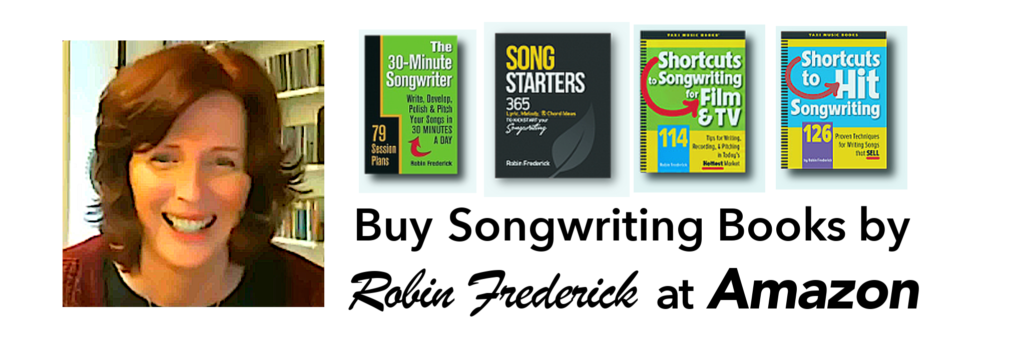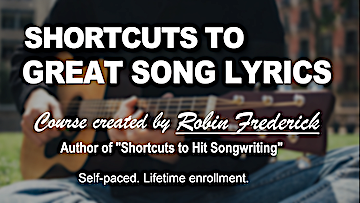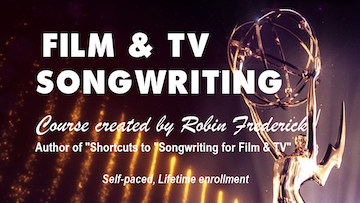LET’S RENOVATE!
I was watching a home renovation show recently. You know… one of those reality TV shows where a couple of energetic, muscular types swing a hammer and—Voila!— they turn a moldy-smelling shack into a sleek duplex complete with landscaping. And I thought to myself: What if we could renovate an older song like that? Give it a fresh coat of paint and plenty of current listener appeal.
Well, I can’t swing a hammer to save my life, but I have a pretty good idea what today’s listeners want in a song. I’ve been studying successful songs for a long time—you can take a look at more than 50 of my Hit Song Guides—and there’s one thing that always seems to jump out as a must-have for today’s audience…
They want a lyric that reveals the singer’s feelings in a way they can relate to and experience for themselves.
SO WHERE DO WE START?
Let’s begin our lyric makeover by looking at what we need to change. Gone are the days when a lyric could simply tell listeners what the singer is feeling and expect them to be interested. For example, here’s the chorus of a very big hit song from 1978 that’s typical of hits from that era.
“Love Will Find a Way” – Pablo Cruise (1978)
It’s all right
Once you get past the pain
You’ll learn to find your love again
So keep your heart open
Cause love will find a way
You can read the complete lyric here.
Now, I loved this song back when it was a hit. And the chorus offers some nice advice. But today’s listeners aren’t likely to be moved. We’ve become less trusting of what people tell us. Simply stating that ‘love will find a way’ just doesn’t cut it. They’ll yawn, say something like “oh, really?” and click on the next song.
Here’s another chorus—this one is from the early ’80s.
“Almost Paradise (Love Theme from Footloose)” (1984)
Oh, almost paradise
We’re knockin’ on heaven’s door
Almost paradise
How could we ask for more?
I swear that I can see forever in your eyes
Paradise
Again, a nice sentiment and a big hit song back in the day, but it isn’t likely to work now. This lyric is confusing: Why is it ”almost paradise”? Is her love not enough? It’s “paradise” in the last line—what changed? And why can’t they “ask for more”?

It’s as if listeners are trying to hear what’s going on behind a locked door. There’s something interesting happening but the song isn’t letting them in.
OPEN IT UP!!!
Today’s listeners want to see what’s going on inside your song. In fact, they want to do more than see it… they want to get involved in it. And they expect you, the songwriter, to make that happen. You’ve got to throw open the doors, clean the windows, knock out a few walls, and let the listener in.
START YOUR LYRIC MAKEOVER
Here are the hands-on tools you need to start renovating an older lyric and and give it a complete makeover.
TRY SOME DIRECT STATEMENTS: Listeners like to be where the action is so this is a great tool. Let’s take a look at how Dua Lipa uses it in her huge Dance/Pop hit “Don’t Start Now.”
If you don’t wanna see me dancing with somebody
If you wanna believe that anything could stop me
Don’t show up, don’t come out
Don’t start caring about me now!
As Dua Lipa sings, it’s as if you’re standing right next her on the nightclub floor while she gives this guy a piece of her mind. Suddenly you’re her BFF going “Yeah! You tell him!” Listeners love that feeling.
CHOOSE A RELATABLE SITUATION: In the chorus of “Rescue Me” by OneRepublic, the singer asks a string of questions in rapid succession.
Would you rescue me? Would you get my back?
Take my call when I start to crack?…
Would you rescue me when I’m by myself?
When I need your love, if I need your help
Would you rescue me?
The listener can feel the urgency in the singer’s voice and, if they’ve ever been in an unreliable relationship, they can relate to the questions! This song has got those listeners hooked in.
GIVE LISTENERS A PHYSICAL EXPERIENCE: To catch and hold the attention of current listeners, your lyric needs to give them an immersive experience. After all, these are the same people who lose themselves in iMax movies with a huge sound system rumbling their seats and they will travel hundreds of miles to ride a monster roller coaster. They’re ready to stand in line if you can deliver the goods.
The right tool for that job is IMAGERY! It’s more than just visual images, it can engage all the senses: touch, taste, smell, and hearing. For example, here’s how Chris Stapleton uses imagery to share the experience of a heartbreak in the song “Cold.”
Girl, the way you broke my heart
It shattered like a rock through a window
Listeners can imagine the speeding projectile and hear the noise of breaking glass. They might even feel a mini-rush of adrenaline. Of course this happens at a subliminal level, but it’s enough to get listeners engaged, literally immersed in what’s going on.
Imagery can also evoke the physical sensation of an emotion. We refer to falling in love, we describe it as feeling dizzy, weightless, giddy. Loneliness might be described as sinking into darkness, and frustration as claustrophobic. This is the way our bodies react to emotion.
In “Cold,” Chris Stapleton and his co-writers use physical sensations in his chorus as he describes how much this breakup hurt him. Instead of “you really, really hurt my feelings” he sings…
Oh, why you got to be so cold?
Why you got to go and cut me like a knife
And put our love on ice?
Oh, girl, you know you left this hole
Right here in the middle of my soul
Oh, why you got to be so cold?
The lyric literally makes you think about being cold, feel the sharpness of a knife, even create an icy shiver. It all takes place beneath your awareness, but the physical expression of emotion is there. That’s why imagery is the essential ingredient in writing universal lyrics for Film & TV.
USE EVEN MORE IMAGERY: In the chorus of “Firework,” Katy Perry and co-writers urge listeners to feel like a firework exploding across the sky, dazzling onlookers with bursts of brilliant color as they discover their self-worth.
Baby, you’re a firework
Come on, show ’em what you’re worth
Make ’em go, “Oh, oh, oh”
As you shoot across the sky
Baby, you’re a firework
Come on, let your colors burst
Make ’em go, “Oh, oh, oh”
You’re gonna leave ’em all in awe, awe, awe
Finding self-confidence and personal worth feels like fireworks? Who knew?!! But just imagine how dreary and preachy this chorus would be without imagery. Instead, listeners can feel like they’re rising, soaring, leaving the crowd below gasping in awe! Today’s listeners love it! They want to feel, not think.That’s what they crave. It doesn’t mean you have to “dumb down” your lyrics. But you do need to express yourself in vivid, creative, physical ways that might not seem obvious at first.
Try It Now
Pull a few of your older songs out of the closet and take a look at the lyrics. Are they inviting listeners to feel what the singer feels? Or are they a string of clichés that stay on the surface? Put yourself in the singer’s shoes and write about how it feels from the inside. compare those feelings to actions, objects, and physical sensations.
For more examples of contemporary songwriting techniques used in successful songs, visit the 50+ free Hit Song Guides on my website I’ll break down both lyrics and melody to uncover the techniques and tools that give these songs their powerful appeal to today’s listeners.



